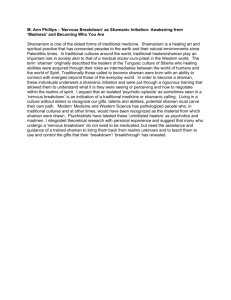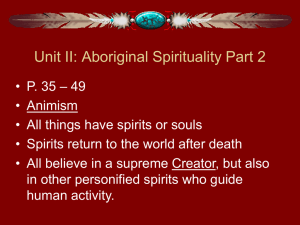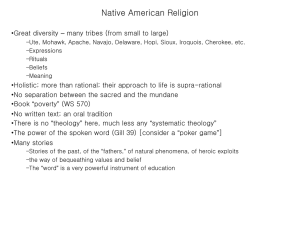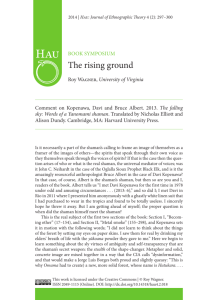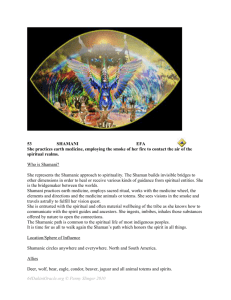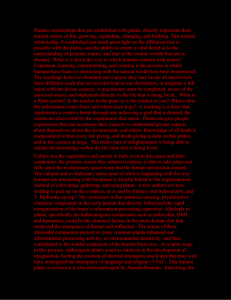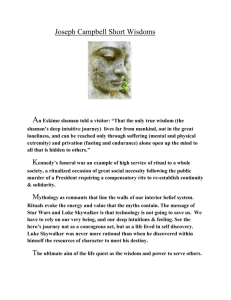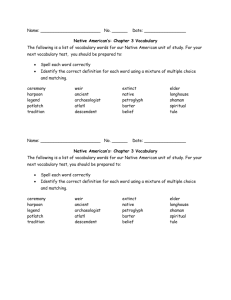1402 LECTURE REVIEW NOTES NINIAN SMART'S 7 DIMENSIONS
advertisement
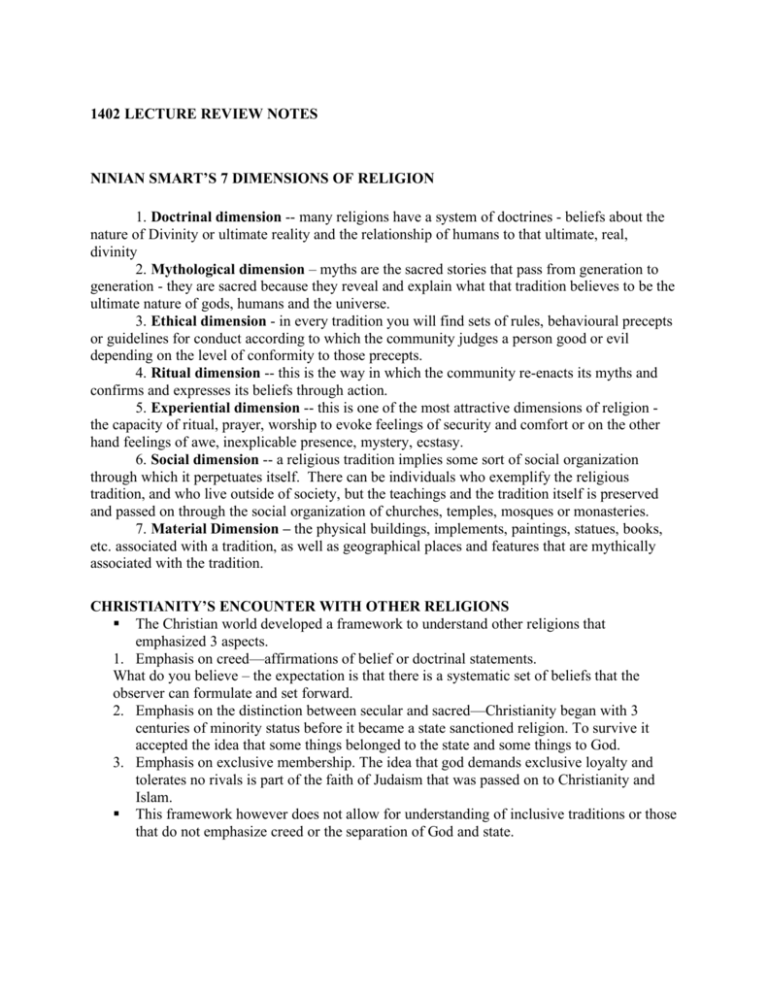
1402 LECTURE REVIEW NOTES NINIAN SMART’S 7 DIMENSIONS OF RELIGION 1. Doctrinal dimension -- many religions have a system of doctrines - beliefs about the nature of Divinity or ultimate reality and the relationship of humans to that ultimate, real, divinity 2. Mythological dimension – myths are the sacred stories that pass from generation to generation - they are sacred because they reveal and explain what that tradition believes to be the ultimate nature of gods, humans and the universe. 3. Ethical dimension - in every tradition you will find sets of rules, behavioural precepts or guidelines for conduct according to which the community judges a person good or evil depending on the level of conformity to those precepts. 4. Ritual dimension -- this is the way in which the community re-enacts its myths and confirms and expresses its beliefs through action. 5. Experiential dimension -- this is one of the most attractive dimensions of religion the capacity of ritual, prayer, worship to evoke feelings of security and comfort or on the other hand feelings of awe, inexplicable presence, mystery, ecstasy. 6. Social dimension -- a religious tradition implies some sort of social organization through which it perpetuates itself. There can be individuals who exemplify the religious tradition, and who live outside of society, but the teachings and the tradition itself is preserved and passed on through the social organization of churches, temples, mosques or monasteries. 7. Material Dimension – the physical buildings, implements, paintings, statues, books, etc. associated with a tradition, as well as geographical places and features that are mythically associated with the tradition. CHRISTIANITY’S ENCOUNTER WITH OTHER RELIGIONS The Christian world developed a framework to understand other religions that emphasized 3 aspects. 1. Emphasis on creed—affirmations of belief or doctrinal statements. What do you believe – the expectation is that there is a systematic set of beliefs that the observer can formulate and set forward. 2. Emphasis on the distinction between secular and sacred—Christianity began with 3 centuries of minority status before it became a state sanctioned religion. To survive it accepted the idea that some things belonged to the state and some things to God. 3. Emphasis on exclusive membership. The idea that god demands exclusive loyalty and tolerates no rivals is part of the faith of Judaism that was passed on to Christianity and Islam. This framework however does not allow for understanding of inclusive traditions or those that do not emphasize creed or the separation of God and state. Why religion?—some propositions • Humans were ignorant about the forces of nature and at the mercy of them and therefore developed a support system, so to speak, that they can turn to for help. • Religion was developed by a few in order to suppress the many • In order to deal with psychological fears and needs • To give meaning to social institutions and develop social solidarity • A god or other spiritual being revealed religion and religious truths to humans at a particular point in their development. The German philosopher Kant, (1724-1804) argued that in the final analysis religious affirmations are unprovable because the operations of reason are dependent on the data received through the senses and religious statements are dependent on the positing of a transcendent reality beyond the world of the senses. Friedrich Schleiermacher (1768-1834) in the tradition of the Romantics and their emphasis on feeling taught that what could not be proved could nevertheless be felt. So intuitive feeling accounted for religious behaviour In the 19th century Darwin’s evolutionary theories regarding the development of species are dominant and gave impetus to evolutionary theories in many other fields, including religion. Scholars began to interpret religion in terms of a biological evolution from primitive to complex. Edward Burnett Tylor, (1832-1917) theorized that “primitive” people developed their idea of gods, ideas of soul and the sense of other from their experiences with death and dreams. Tyler also felt from his field work that primitive people believed that these souls (anima) not only inhabited people but all natural forms; everything was animated with spirits which could be helpful or harmful to people, could be offended or pleased. Religion then began as the practice of appeasing the spirits. Then from the animistic understanding developed ancestor worship i.e. appeasing the spirits of the dead. Nature spirits developed into a polytheistic pantheon of deities - sun, moon, water, earth etc. and finally, monotheistic religions developed. This view was widely held for many years. An alternate theory was developed by Max Mueller (1823-1900) Through his study of the language of myth especially the hymns of the Vedas, he was convinced that the origins of religion lay in the observation of the forces of nature and then their personification through language. Natural phenomena are given names and personified as entities and eventually the name becomes the deity. Mueller referred to religion as ‘a disease of language’. In his view—primitive people identified the forces in nature, personified them, created myths to describe their activities, and eventually developed pantheons and religions around them. Karl Marx (1818-1883) saw the origin of religion in the social and economic struggle between classes. His ideas continue to have a wide following today. According to Marx, “Man makes religion, religion does not make man. Religion is the self-consciousness and self-esteem of man who either has not yet found himself or has already lost himself again … Religion is the sigh of the oppressed creature, the heart of a heartless world, just as it is the spirit of spiritless conditions. It is the opium of the people.” Sigmund Freud (1856-1939), the founder of psychoanalysis, saw religion as revolving around guilt -- the primeval guilt, so to speak that he identified and that is reflected in the Greek myth of Oedipus who killed his father and married his mother, is the guilt arising from desire for one’s mother and hatred of one’s father as the person who stands in the way and eventually must be destroyed. In Freud’s view, because of this subconscious hatred and guilt, humans project the idea of a father god, which they attempt to appease in order to allay the guilt of sexual desire for the mother. Emile Durkheim 1858-1917 found the origin and essence of religion in the identity of the social group. He uses the concept of the “totem” or clan identity. Totem is an Ojibway word referring to the animal or plant species that is identified with the clan and that is set apart and killed or eaten only on special ritual occasions or by ritual specialists. In the 20th century social-scientists stopped looking for origins and turned more to the analysis of the function of religion as it is now lived. They speak more about the social function of religion than prehistoric development. Clifford Geertz is one of the major 20th century writers in this vein. His definition of religion: “A religion is: 1, a system of symbols which acts to 2. establish powerful pervasive and longlasting moods and motivations in men by 3. formulating conceptions of a general order of existence and 4. clothing these conceptions with such an aura of factuality that 5. the moods and motivations seem uniquely realistic. “ from Religion as a Cultural System. 1966 These theories all view religion as a product of cultural circumstances, psychological needs, a product of human causes and imagination. Religious people were alarmed at this social-scientific trend at the turn of the century and we have a response by such (insider) people as Rudolph Otto, german philosopher of religion (1869-1937) wrote The Idea of the Holy – he characterized human awareness of the divine in terms of an overpowering yet fascinating mystery. The word he coined for that feeling is numinous. Rudolf Otto defines sacred as “wholly other” and the experience of the sacred invokes a feeling of both terror and fascination—the experience of the numinous. Sacred and Profane Mircea Eliade considers this to be the major distinction in religious thought. That which is set apart from the ordinary, the profane – profanum outside the temple Religion is made up of gestures and activities that make no sense if ordinary practical reality is all there is. Religion adds to what is practical by presupposing or implying another point of reference. That point of reference we could call the sacred or sacred reality. The religious perspective always presupposes the sacred -- a reality beyond the visible - seen and heard only by that dimension of ourselves that people would call soul or perhaps innermost sense. A reality that is the basis of all that is visible and tangible. In ordinary time and space, things change, lose power, become weak -- sacred time is always the no time of the eternal beginning where power and strength and vitality are newly born. CHARACTERISTICS OF THE SACRED Set apart, distinct a. separate or transcendent – like the Judeo-Christian God, what Otto calls ‘wholly other’ – the experience of that is the experience of the numinous b. in-dwelling or immanent – like the Hindu concept of Brahman— is accessed through what might be called mystical experience – the experience of nondifferentiation SHAMANISM I read somewhere of a shepherd who, when asked why he made, from within fairy rings, ritual observances to the moon to protect his flocks, replied: “I’d be a damn’ fool if I didn’t!” (Dylan Thomas, Note to The Collected Poems of Dylan Thomas, 1934-1952) The Welsh shepherd’s answer reflects a world-view shared by small-scale tribal and traditional peoples around the world: an understanding of the world as ‘being’ and of living in the world as constituted of relationships between ‘beings’. Shamanism: derived from the Tungus word for one of their ritual specialists – now used as a general term for a category of practices found in differing degrees in almost all human societies. This category of practices may be briefly described as: The regulation and transformation of human life and human society through the use (or purported use) of alternate states of consciousness by means of which specialist practitioners are held to communicate with a mode of reality alternative to, and more fundamental than, the world of everyday experience. Geoffrey Samuel, Civilized Shamans, p. 8. Three basic characteristics. 1. shamanism presupposes a dualistic conception of the person and of the world: this indicates the double nature of the person consisting of body and separable soul or souls, as well as the double nature of the external environment which consists of ‘this’ world of materiality and the ‘other’ world of the spirit. 2. shamanism involves a special type of communication – meaning that shamans can establish direct communication with the other world at will, both by bringing the spirits into this world or by sending their souls into the other world. 3. shamanism implies a social function indicating that the shaman acts in response to social demand. CHARACTERISTICS OF SHAMANIC WORLD VIEW • • • • • • • • Spiritualization of the environment – ‘everything is alive’; everything imbued with lifeessence or soul – the universe is a universe of ‘beings’ Belief in mutual all-embracing connections in nature Basic world-view is that everything is interrelated and relational. To maintain balance requires the right relationship with everything – the unseen world of spirits, the world of animals, nature, people, and the power that resides in everything. The right relationship is one that recognizes and respects reciprocity between these various aspects of life. It is a relationship that values humility and caution and politeness to all things. Purification practices are important since we continually endanger ourselves as well as our community by thoughtless acts and words. Respect for everything is enjoined and caution in actions. Cutting trees, digging the earth, breaking rocks all interfere with nature and can result in harm. However, in doing what one has to do to survive both in this world and the spirit world, a certain measure of ingenuity and deception is acceptable – the trickster is a prominent and admired figure in native traditions. In the Evenck ritual the shaman tries to trick the disease-spirit out of the body and into the reindeer. No human superiority over nature – mankind operates like all other life forms, within nature and subject to the same rules. The cosmos is close i.e. the other worlds of the cosmos and their inhabitants are linked to the well-being of humans – and are accessible to special people i.e. the shamans. The other worlds because they are inhabited by gods and spirits are sacred The sacred powers of the cosmos are close – a person can possess the qualities of both human and spirit. Can join the spirit world – these are the shamans and they are chosen by the spirits themselves. The shaman’s initiation, the becoming a shaman, takes place in the world of the spirits, in the sacred time space of the spirit world The type of social consciousness reflected in shamanism is the small human collective united by blood ties – in other words religious activity is intended to defend and/or make prosperous a group of kinsmen. The rituals and stories and world-view are tied to the spatially defined environment, community and entire way of life. This creates a situation that is “not for export” The shaman can carry out his tasks with the help of the spirits only – meaning that in a sense the shaman is powerless without the spirits – but in another sense he controls the spirits. Beyond that, the shaman has to continually prove his mastery of the spirits – his efficacy as a shaman and his position in the society is dependent on his performance. The relationship between the shaman and the spirits is very concrete – in many cases the shaman or shamaness is married to the helper spirit – you have the example of a voodoo marriage contract between a woman and her spirit husband. In the hunting tribes of Siberia like the Tungus and the Buryat – it is the shaman’s relationship with the spirits that ensure the supply of game. This very complex exchange is managed by the shamans through their marriages with the female animal spirits or the spirit sisters or daughters of game-giving spirits. The marriage with the shaman in the role of the husband and the game spirit in the role of wife sets out the terms of the game-supply contract between humans and animals and indicates the dominance of the men over the game as the husband over the wife. But in the end, once his grandchildren are old enough to hunt, then a hunter should disappear into the forest as if he were returning his own flesh to the spirits of the game animals. The shaman is understood to be chosen by the spirits and recreated in a rite of initiation that is the culmination of a call of some kind that is manifested in some cultures by the ‘shaman’s disease’ or in others by a dream or vision. The signs of someone’s predilection to be a shaman among the arctic tribes are – hiding from the light, hysterical singing or crying; sitting passively withdrawn on the ground or bed; running off into the bush; hiding, climbing trees – such behaviour betokens possession by a spirit. The initiation is a reenactment of ritual death and resurrection with supernatural qualities. In many arctic cultures the defining quality of the shaman is a mysterious self-generated light called qaumaneq “illumination’ or ‘lightenening’ experienced inside the head. The shaman visits the other cosmic spheres and shamanic rituals more or less reenact his visit to the other worlds. Communication with spirits occurs in a state of ecstasy. “Ecstasy” refers to the trance states which are a common attribute of shamanic rites. To be a shaman does not signify professing particular beliefs but rather refers to a certain mode of communication with the supernatural. In the classic Tungus case ecstatic behaviour is a crucial feature of shamanizing and central to the shaman’s role. The songs the gestures the drama are standardized and conventionalized to an degree, but there is always a point in the séance where the shaman is in a state that involves some altered state of consciousness METHODS OF ACHIEVING ALTERED STATES OF CONSCIOUSNESS 1. Reduction of sensory input/and motor activity changing the pattern of sensory data exposure to repetitive monotonous stimuli - mantra repetition rubbing a stone in circles - includes hypnotic trance - social isolation - mystics and ascetics 2. Increase of sensory input/motor activity/emotion -dance and trance in response to drumming - emotional contagion in group or mob situations - emotional arousal, mental fatigue - conversion - healing ceremonies depend on this-spirit possession and shamanistic or divinatory trances 3. Increased alertness or mental involvement - praying - watching for a sign - listening to a charismatic speaker 4. Decreased alertness and relaxation of critical faculties - passive mind - no goal oriented thinking 5. Direct results of alterations in body chemistry or neurophysiology - dehydration, sleep deprivation, hypoglycemia, hormone imbalance, drugs note that these overlap in any real situation such as a shamanic seance. As distinct from mystics whose practices are usually in solitude, the activity of a shaman is a social affair -- they study and practice in private during the initiation period but their real work is done with the community with an audience. There are a number of factors operating to make the seance successful -- the stimulus drums, chanting etc.; the social expectation of the group; the shaman’s expectation of him/herself; all that the shaman knows of the supranormal; the overwhelming emotional pressure created by all this. THE PROCEDURE OF A SEANCE AMONG SIBERIAN SHAMANS: preparation - physical, perhaps by fasting or meditative contemplation; breaking the hold of the ordinary world - focusing of thoughts via physical things like the shaman’s dress or other ritual implements, the drum, setting the stage. induction of the trance - this is the period when the shaman is assembling the spirit helpers -- begins with the rhythmical stimulus -- for the Siberians and many other communities this is drumming -- beginning slow and soft and later increasing in volume and tempo. If hallucinogens or other substances like tobacco or alcohol are used, then this is the stage at which they are used. The ordinary world is extinguished with the extinguishing of lights - the noise of the drumming drowns out the thoughts of this world. As the shaman sings his song, he actualizes the spirits calling, invoking them and bringing them near him - describing for the audience the spirit, the sound of the spirit -usually animal sounds as the helpers are usually animal spirits -- its dwelling place in the other world and its journey to the tent. climax of the seance is the arrival or presence of the spirit or spirits at the seance and the encounter. The purpose of the seance is described and the help of the spirits requested. Closing – in which the spirits are dismissed and the community requests other services of the shaman such as reading omens or fortune-telling. The shaman’ trance varies according to what he is doing. The spirits are manifested in number of different ways: 1. Possession – in which the shaman completely identifies with the spirit and the audience regards the person in front of them as the spirit itself -- this type of trance requires a third party assistant to mediate between the spirit and the audience since the shaman is not there. 2. Dual role -- where the shaman and the spirits coexist in a dialogue situation and the spirits are understood to be speaking outside the shaman. This is the kind of situation observed among the Chukchi shamans where the shaman’s ventriloquist talents are used to create a dazzling performance of several spirits appearing in different corners of the tent communicating with the shaman. 3. The soul journey-- seance in which the shaman’s soul travels to the other world and he describes in song for the audience all that he sees and experiences on the way to the other world. In this type of seance only the shaman is understood to be seeing or relating to the spirits and basically reporting back. A word about soul. This word used to describe the invisible aspect of the person has nothing to do with any understanding of soul that one might have from either western religious traditions such as Christianity or Judaism or Islam or eastern religious traditions such as Hinduism. The concept of soul as the unitary eternal essence of a person is entirely missing. In shamanism, multiple souls are associated with an individual—e.g. the life soul, loss of which means loss of life, the dream soul which wanders about in dream life, Some kinds haunt the graveyards in ethereal but visible form, other kinds live on the surface of the body or in clothing, some reincarnate in the newborn children of the clan, some live apart from the person and join him during sleep. According to one Siberian tribal community, the Ob Ugrians, when the person dies, the grave-soul continues its shadow-like existence in the graveyard until the physical remains of the person are entirely disintegrated, at this point, the “person” undergoes a second death when the grave-soul is transformed into a beetle and “after the third death in the form of this animal, the person finally disappears without trace.” This is so fundamentally different from the concept of soul as it is understood in any of the world’s major religions that one wonders whether we should use the same word to refer to these concepts. Perhaps a word like “spirit-energy” would give us a much better idea of the animistic world-view.
